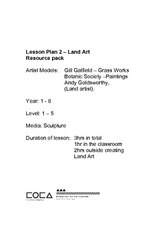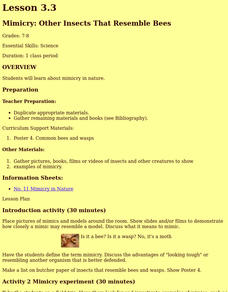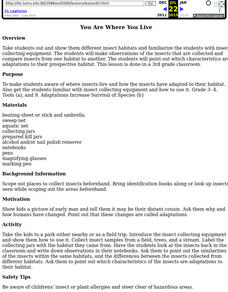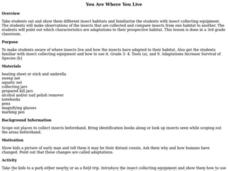Curated OER
Pio, Pio, Que Frio
Learners investigate the characteristics of living things. They determine that different organisms have different needs and describe and compare them. They draw and verbally respond about their favorite animal.
Curated OER
Growth and Changes in Plants
Pupils investigate the growth and changes in plants. They view a video and discuss the changes in plants. They work in small groups to demonstrate vocabulary words to the class. They visit a green house and take pictures of plants to...
Curated OER
Petroglyphs: Protecting the Past
Fourth graders investigate the three types of rocks and study about petroglyphs. They explore why petroglyphs were used by the Nez Perce People. Students investigate the properties of the three types of rocks and they discuss cultural...
Curated OER
The Bulbs: Camas and Daffodil
Fourth graders become aware of the importance of the camas bulb to the Nez Perce people, they learn the parts of plants, and gain understanding of the interdependence of Nature. They study about the possible causes and outcomes of global...
Curated OER
Land Art
Pupils use natural materials outside to create a work of art. In this land art lesson plan, students plan their sculpture inside in one day and create it outside over a period of 2 days.
Alabama Learning Exchange
Simple Machines Internet Research
Young scholars identify six types of simple machines, then use the Internet for research.
Curated OER
Observing and Recording Biological Data
Students create their own definition of life. They identify the eight characteristics of life in organisms. They compare and contrast the characteristics of living and nonliving things.
Curated OER
Animal Adaptations
Tenth graders participate in an arthropod scavenger hunt. In groups of two, they identify and collect two specimens of arthropods in the school area, and create a table of all the specimens and what class they belong to.
Curated OER
Finding Out About the Stars and Planets
Students complete a web-based activity to study the planets and solar system. Students complete a number of activities including a slide show that depict the true facts about planets.
Curated OER
Antifreeze - Anti Fish
Students participate in the production of a play that highlights the direct linkage between storm drains and natural river, stream, or creek ecosystems. They explore their thoughts, feelings, and actions through dramatic interaction and...
Curated OER
It's a Small World After All! (Pond Microcosms)
Students use microscopes to investigate the diversity of life that exists in pond water. They then conduct a controlled investigation to study the effect of a pollutant (rice) on a microcosm ecosystem.
Curated OER
EWOC2006-Make your own weather forecast - WEST
Students explore making their own weather forecast. They view and discuss a forecasting PowerPoint presentation. Students analyze radar and satellite imagery. They compile many ways to observe clouds.
Curated OER
Mimicry: Other Insects That Resemble Bees
Students design a conceptual experiment to test whether mimics actually benefit from the fact they resemble other organisms or objects. They define the term mimicry. They focus on insects that resemble bees and wasps.
Curated OER
Fish Hunt
Students prepare for a unit on aquarium maintenance by naming all the different kinds of fish they have seen either in aquariums, at home, or in the community. They use classroom computers to email other classrooms around the world for...
Curated OER
Animals and Habitats of the Chesapeake Bay
Students work in small groups to discover the various habitats present in Chesapeake Bay and the animals that live in them. After investigating the habits and lives of the animals they will draw conclusions about other habitats the...
Curated OER
Toilet to Tap?
Students answer the question, 'Should San Diego reclaim its water for fresh drinking water?' They make a poster explaining the position: "Yes," drink reclaimed water; or "No," don't drink reclaimed water.
Curated OER
Plant Life for Kids
In these plant life worksheets, students complete a instructional activity about parts of a plant, plant life, plant life cycle sequence, and then complete a plant life mini book.
Curated OER
How Do Weather Conditions and Lunar Cycles Affect Fishing Success?
Students use weather measuring devices to record and study weather conditions at different locations, during different times. They attempt to draw conclusions about the relationship between weather conditions, lunar cycle and fishing...
Curated OER
Lake Billy Chinook
Young scholars explore aerial photographs and maps of Round Butte Dam. They examine the land modifications necessary to create a dam. After reading a book about building a dam, students compare the environmental impact of Lake Billy...
Curated OER
A Rainbow Under the Sea: How Do Animals Survive in the Ocean?
Second graders, with adult help, create a PowerPoint presentation on a selected ocean animal.
Curated OER
Aquatic Organisms
Students create a poster describing the five characteristics of a salt water organism compared to a fresh water organism.
Curated OER
You Are Where You Live
Students explore where insects live and how they have adapted to their environment.
Curated OER
You Are Where You Live
Third graders observe insects in a number of habitats. They recognize which insect characteristics are adaptations to their habitats.
Curated OER
GeoSleuth Schoolyard
Students discover that geology is something that is all around them. In groups, they participate in an activity in which they collect evidence and make observations. They solve a "murder mystery" in examining the history of a landscape.

























